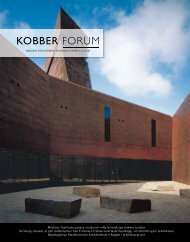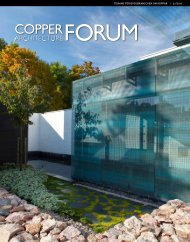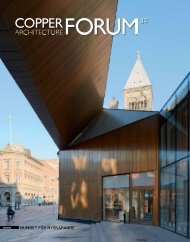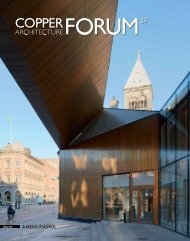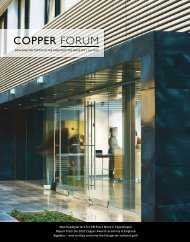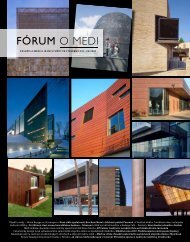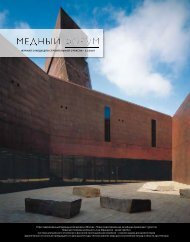renovation of the clock tower at Helsinki railway station - Copper ...
renovation of the clock tower at Helsinki railway station - Copper ...
renovation of the clock tower at Helsinki railway station - Copper ...
You also want an ePaper? Increase the reach of your titles
YUMPU automatically turns print PDFs into web optimized ePapers that Google loves.
COPPER – KEEPING DISEASE AWAY<br />
The UK’s <strong>Copper</strong> Development Associ<strong>at</strong>ion (CDA) is <strong>at</strong> <strong>the</strong> forefront <strong>of</strong> promoting research<br />
and development into <strong>the</strong> antimicrobial effects <strong>of</strong> copper. CDA Director Angela Vessey<br />
discusses <strong>the</strong> implic<strong>at</strong>ions for interior design, architectural ironmongery and fittings –<br />
particularly in healthcare buildings. But this unique capability <strong>of</strong> copper could have much<br />
wider implic<strong>at</strong>ions for <strong>the</strong> design <strong>of</strong> all types <strong>of</strong> buildings.<br />
Last year’s swine flu crisis highlighted <strong>the</strong><br />
role th<strong>at</strong> ‘touch surfaces’, such as door handles,<br />
can play in <strong>the</strong> spread <strong>of</strong> infection,<br />
acting as reservoirs <strong>of</strong> infectious p<strong>at</strong>hogens<br />
just waiting to be transferred to <strong>the</strong> next<br />
hand. Hand washing and regular cleaning<br />
are <strong>the</strong> two prevent<strong>at</strong>ive actions recommended<br />
but recontamin<strong>at</strong>ion is always just<br />
a touch away: germs can survive on common<br />
m<strong>at</strong>erials such as stainless steel, plastic<br />
and aluminium, for days – even months. To<br />
prevent this, architects are now specifying<br />
Antimicrobial <strong>Copper</strong> touch surfaces for<br />
healthcare buildings, where infection prevention<br />
and control are key concerns.<br />
copper showed an impressive 90–100%<br />
reduction in contamin<strong>at</strong>ion<br />
COMPELLING EVIDENCE<br />
The scientific evidence for copper’s antimicrobial<br />
efficacy is compelling: research <strong>at</strong><br />
<strong>the</strong> University <strong>of</strong> Southampton has demonstr<strong>at</strong>ed<br />
copper’s exceptional efficacy against<br />
<strong>the</strong> headline-making p<strong>at</strong>hogens – MRSA,<br />
C. difficile, Influenza A and E. coli. Interestingly,<br />
results have shown th<strong>at</strong> copper<br />
has unm<strong>at</strong>ched efficacy, outperforming<br />
silver-containing ‘antimicrobial’ m<strong>at</strong>erials.<br />
<strong>Copper</strong> has also been put to <strong>the</strong> test<br />
in a clinical trial <strong>at</strong> Selly Oak Hospital in<br />
Birmingham, in which frequently-touched<br />
surfaces – such as taps, toilet se<strong>at</strong>s, light<br />
switches and door furniture – were replaced<br />
with copper equivalents. The results showed<br />
an impressive 90–100% reduction in contamin<strong>at</strong>ion<br />
on <strong>the</strong>se surfaces compared to<br />
controls, and a subsequent Department <strong>of</strong><br />
Defense-funded project in <strong>the</strong> US backed<br />
up <strong>the</strong> findings earlier this year.<br />
34<br />
COPPER ARCHITECTURE FORUM – 29/2010<br />
It is not just pure copper th<strong>at</strong> has antimicrobial<br />
properties – bronzes, brasses, nickel<br />
silvers and copper-nickels are efficacious<br />
too. In fact a landmark registr<strong>at</strong>ion in 2008<br />
led to nearly 300 copper alloys being recognised<br />
by <strong>the</strong> US Environmental Protection<br />
Agency as <strong>the</strong> first solid m<strong>at</strong>erials eligible<br />
to be marketed with public health claims<br />
including a 99.9% reduction <strong>of</strong> <strong>the</strong> 6 tested<br />
bacteria within two hours (MRSA, Staphylococcus<br />
aureus, Enterobacter aerogenes,<br />
Pseudomonas aeruginosa, E. coli O157:H7.<br />
and Vancomycin-resistant Enterococcus<br />
faecalis).<br />
With a range <strong>of</strong> differently-coloured copper<br />
alloys available to suit different designs<br />
and applic<strong>at</strong>ions, and copper’s exceptional<br />
environmental credentials, it’s little wonder<br />
high-pr<strong>of</strong>ile healthcare projects are already<br />
incorpor<strong>at</strong>ing copper. For example, a cutting-edge<br />
facility <strong>at</strong> Sheffield’s Nor<strong>the</strong>rn<br />
General Hospital was designed with <strong>the</strong><br />
goal <strong>of</strong> ‘setting <strong>the</strong> gold standard for infection<br />
prevention’, and Antimicrobial <strong>Copper</strong><br />
door furniture was specified throughout in<br />
a bid to reduce <strong>the</strong> risk <strong>of</strong> healthcare associ<strong>at</strong>ed<br />
infections in particularly vulnerable<br />
p<strong>at</strong>ients. Here, Dr Frank Edenborough,<br />
Consultant <strong>of</strong> <strong>the</strong> Sheffield Adult Cystic<br />
Fibrosis Centre wanted to cre<strong>at</strong>e an environment<br />
to meet both <strong>the</strong> clinical and personal<br />
needs <strong>of</strong> p<strong>at</strong>ients: a ward th<strong>at</strong> would combine<br />
key infection prevention measures<br />
with a comfortable and appealing environment<br />
to mitig<strong>at</strong>e <strong>the</strong> boredom <strong>of</strong> sometimes<br />
very prolonged stays.<br />
WIDER APPLICATIONS<br />
Recognising copper’s beauty as well as its<br />
antimicrobial properties, a piece <strong>of</strong> copper<br />
artwork was commissioned for <strong>the</strong> clinic,<br />
which will greet p<strong>at</strong>ients, staff and visitors<br />
when <strong>the</strong>y enter. The artwork is by prominent,<br />
London-based metal smith Adaesi<br />
Ukairo, who has a long-standing love <strong>of</strong><br />
working with copper and its alloys. “I was<br />
originally drawn to copper for its malleable<br />
qualities and its ability to p<strong>at</strong>in<strong>at</strong>e beautifully,<br />
and it rapidly became <strong>the</strong> m<strong>at</strong>erial <strong>of</strong><br />
choice to evoke my designs,” she said. “It<br />
was <strong>the</strong> perfect m<strong>at</strong>erial to embark on an<br />
ambitious design for a 2 metre-long wall<br />
piece for <strong>the</strong> clinic. My intention is for <strong>the</strong><br />
piece to act as a window, allowing <strong>the</strong> viewer<br />
to soar through a landscape, transported<br />
momentarily as <strong>the</strong>y enter <strong>the</strong> clinic.”




